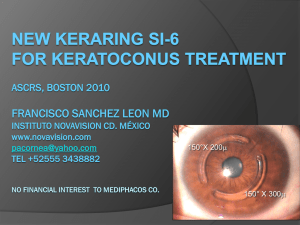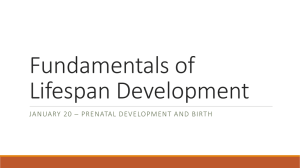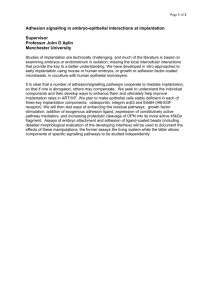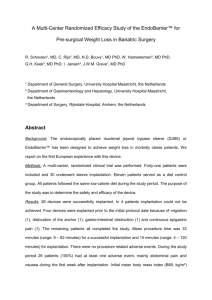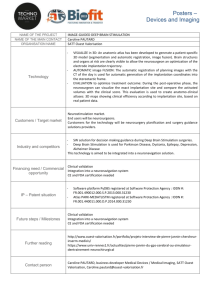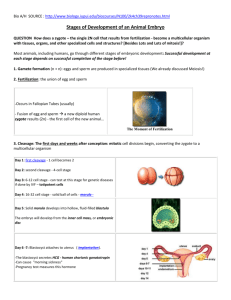11-deoxy prostaglandin F , a thromboxane A2 receptor (TP) Lpar3 females
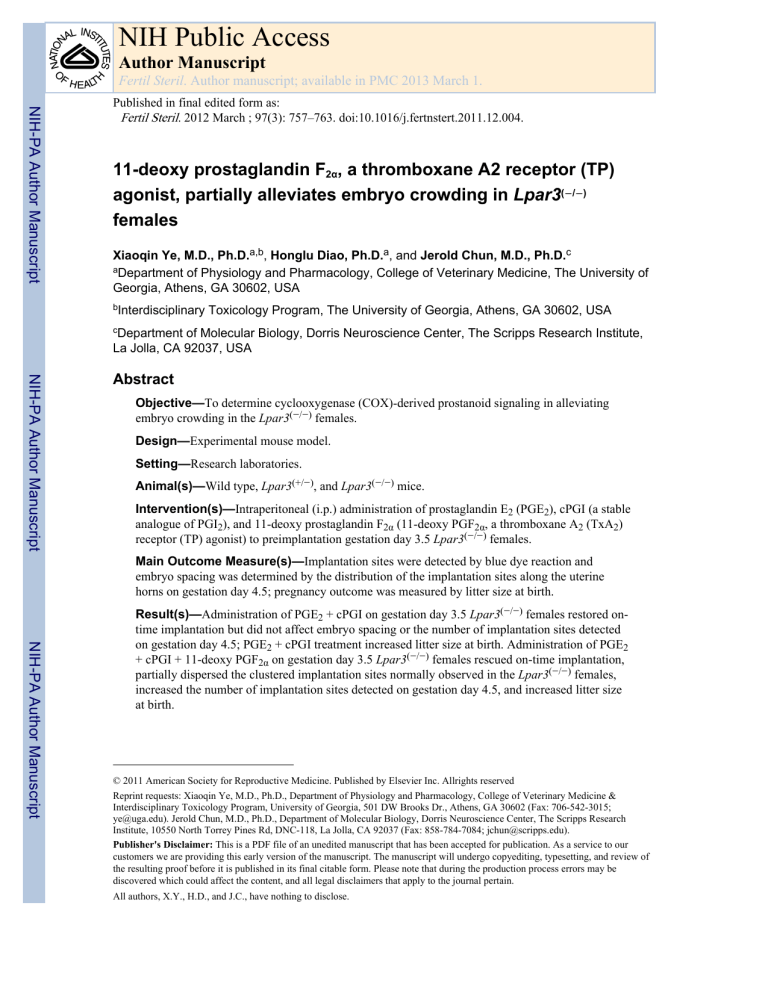
NIH Public Access
Author Manuscript
Fertil Steril . Author manuscript; available in PMC 2013 March 1.
Published in final edited form as:
Fertil Steril. 2012 March ; 97(3): 757–763. doi:10.1016/j.fertnstert.2011.12.004.
11-deoxy prostaglandin F
2 α
, a thromboxane A2 receptor (TP) agonist, partially alleviates embryo crowding in Lpar3
(
−
/
−
)
females
Xiaoqin Ye, M.D., Ph.D.
a,b
, Honglu Diao, Ph.D.
a
, and Jerold Chun, M.D., Ph.D.
c a Department of Physiology and Pharmacology, College of Veterinary Medicine, The University of
Georgia, Athens, GA 30602, USA b Interdisciplinary Toxicology Program, The University of Georgia, Athens, GA 30602, USA c Department of Molecular Biology, Dorris Neuroscience Center, The Scripps Research Institute,
La Jolla, CA 92037, USA
Abstract
Objective— To determine cyclooxygenase (COX)-derived prostanoid signaling in alleviating embryo crowding in the Lpar3
(
−
/
−
)
females.
Design— Experimental mouse model.
Setting— Research laboratories.
Animal(s)— Wild type, Lpar3
(+/
−
)
, and Lpar3
(
−
/
−
)
mice.
Intervention(s)— Intraperitoneal (i.p.) administration of prostaglandin E
2
(PGE
2
), cPGI (a stable analogue of PGI
2
), and 11-deoxy prostaglandin F
2 α
(11-deoxy PGF receptor (TP) agonist) to preimplantation gestation day 3.5 Lpar3
2 α
(
−
/
−
)
, a thromboxane A
females.
2
(TxA
2
)
Main Outcome Measure(s)— Implantation sites were detected by blue dye reaction and embryo spacing was determined by the distribution of the implantation sites along the uterine horns on gestation day 4.5; pregnancy outcome was measured by litter size at birth.
Result(s)— Administration of PGE
2
+ cPGI on gestation day 3.5 Lpar3 (
−
/
−
) females restored ontime implantation but did not affect embryo spacing or the number of implantation sites detected on gestation day 4.5; PGE
2
+ cPGI treatment increased litter size at birth. Administration of PGE
2
+ cPGI + 11-deoxy PGF
2
α
on gestation day 3.5 Lpar3 (
−
/
−
) females rescued on-time implantation, partially dispersed the clustered implantation sites normally observed in the Lpar3 (
−
/
−
) females, increased the number of implantation sites detected on gestation day 4.5, and increased litter size at birth.
© 2011 American Society for Reproductive Medicine. Published by Elsevier Inc. Allrights reserved
Reprint requests: Xiaoqin Ye, M.D., Ph.D., Department of Physiology and Pharmacology, College of Veterinary Medicine &
Interdisciplinary Toxicology Program, University of Georgia, 501 DW Brooks Dr., Athens, GA 30602 (Fax: 706-542-3015; ye@uga.edu). Jerold Chun, M.D., Ph.D., Department of Molecular Biology, Dorris Neuroscience Center, The Scripps Research
Institute, 10550 North Torrey Pines Rd, DNC-118, La Jolla, CA 92037 (Fax: 858-784-7084; jchun@scripps.edu).
Publisher's Disclaimer: This is a PDF file of an unedited manuscript that has been accepted for publication. As a service to our customers we are providing this early version of the manuscript. The manuscript will undergo copyediting, typesetting, and review of the resulting proof before it is published in its final citable form. Please note that during the production process errors may be discovered which could affect the content, and all legal disclaimers that apply to the journal pertain.
All authors, X.Y., H.D., and J.C., have nothing to disclose.
Ye et al.
Conclusion(s)— The TP agonist 11-deoxy PGF
2 α
Lpar3
(
−
/
−
)
can partially alleviate embryo crowding in the
females and embryo crowding likely contributes to reduced litter size in the Lpar3
(
−
/
−
) females.
Keywords lysophosphatidic acid (LPA) receptor 3; COX-derived prostanoids; prostanoid receptors; prostanoid receptor agonists; 11-deoxy PGF
2 α
; embryo implantation; embryo spacing
Page 2
Introduction
Embryo spacing in polyovulating animals tends to be evenly spaced along each uterine horn, which may minimize early embryo mortality resulting from local overcrowding. Even embryo spacing is thought to be achieved through uterine myometrial contractions (1–3).
Lysophosphatidic acid (LPA) is an extracellular lipid mediator with myriad actions that include cell proliferation, survival, and migration. LPA signals through six known G protein-coupled receptors (GPCRs), LPA
1–6
(4, 5). LPA signaling has been implicated in many aspects of female reproduction, such as fertilization, embryo development, ovum transportation in the oviduct, uterine contraction, embryo implantation, and pregnancy maintenance (reviewed in (6, 7)). LPA
3
-mediated signaling is specifically involved in two separate events: implantation timing and embryo spacing (8, 9). Deletion of Lpar3 in mice results in delayed embryo implantation and aberrant embryo spacing, which is reflected by the crowding of implantation sites on the cervical half of a uterine horn (proximal uterine segment) and multiple embryos sharing a single placenta (8). Lpar3
(
−
/
−
)
uterine horns lose
LPA
3
agonist-induced uterine contraction (9), supporting the theory that dysregulated myometrial activities may contribute to embryo crowding in the Lpar3
(
−
/
−
)
females. LPA
3 has also been implicated in the aberrant embryo spacing induced by transient β
2
adrenoceptor activation (10).
Delayed embryo implantation and aberrant embryo spacing phenotypes in Lpar3
(
−
/
−
) females have also been observed in rats and mice treated with indomethacin, a cyclooxygenase (COX) inhibitor (11–14), and Pla2g4a phospholipase A
2
α (cPLA
2
α ) (15). Both Lpar3
(
−
/
−
)
(
−
/
−
)
mice deficient for cytosolic
females and Pla2g4a
(
−
/
−
)
females have reduced uterine expression of COX-2, the rate limiting enzyme for prostagnoid synthesis (8,
15). These observations reveal the importance of COX-derived prostanoid signaling in ontime embryo implantation and even embryo spacing (8, 11–15).
COX-derived prostanoids include prostaglandins PGD
2
, PGE
2
, PGF
2
α , PGI
2
, and thromboxane A
2
(TxA
2
), which activate their respective GPCRs, DP
1–2
, EP
1–4
, FP, IP, and
TP (16, 17). These GPCRs are expressed in the uterus and mediate the effects of COXderived prostanoids in myometrial activity (18, 19). EP
1
, EP
3
, FP, and TP have a contractile effect on the myometrium, while DP
1–2
, EP
2
, EP
4
, and IP have a relaxant effect (16, 18, 20,
21). It has been demonstrated that PGE
2
and cPGI (a stable analogue of PGI normal implantation timing but fail to rescue embryo spacing defect in and Pla2g4a
(
−
/
−
)
2
Lpar3
) can restore
(
−
/
−
)
females
females (8, 15). It has not been determined if any specific COX-derived prostanoid signaling affects embryo spacing. PGE
2
can induce contractile (via EP
1
and EP
3
) and relaxant (via EP
2
and EP
4
) effects whereas cPGI only induces relaxant (via IP) effects.
Since they do not have an obvious effect on embryo spacing yet can rescue on-time implantation in Lpar3
(
−
/
−
)
females (8), it was hypothesized that COX-derived prostanoid(s) that can induce a contractile effect rather than a relaxant effect on the myometrium may alleviate embryo crowding in Lpar3
(
−
/
−
)
females.
Fertil Steril . Author manuscript; available in PMC 2013 March 1.
Ye et al.
Page 3
Materials and Methods
Animals
Wild type, Lpar3
(+/
−
)
, and Lpar3
(
−
/
−
)
mice (129/SvJ and C57BL/6 mixed background) were generated and genotyped as described (8). The animals were housed on a 12-hour light/dark cycle (6:00 AM to 6:00 PM) at 23±1°C with 30–50 relative humidity. All methods used in this study were approved by the Animal Subjects Programs of The Scripps Research
Institute and the University of Georgia and conform to National Institutes of Health guidelines and public law.
Mating, administration of prostanoid receptor agonists, detection of implantation sites, gestation period, and litter size
Females were mated with fertile males and checked for a vaginal plug next morning
(midnight of mating night was designated as day 0 00:00). Implantation sites were detected by intravenous injection of blue dye on gestation day 4.5 for the control mice (including wild type and Lpar3
(+/
−
)
, both of which have normal embryo implantation (8)), which was designated as Group 1 in this study, and on gestation day 5.5 for the Lpar3
(
−
/
−
)
females
(undetectable implantation sites on gestation day 4.5 due to delayed implantation (8)), which was designated as Group 2. The previously reported treatment regimen was followed (8) to determine COX-derived prostanoid signaling in embryo spacing in Lpar3
(
−
/
−
)
females.
Briefly, gestation day 3.5 Lpar3
(
−
/
−
)
females were intraperitoneally injected (at 10:00 and
18:00, respectively) with 100 μ l of PGE
2
(5 μ g) + cPGI (5 μ g) in vehicle (10% ETOH with saline), which was designated as Group 3, or 100 μ l of PGE
2 deoxy PGF
2 α
(5 μ g) + cPGI (5 μ g) + 11-
(5 μ g) in vehicle, which was designated as Group 4. Implantation sites were detected on gestation day 4.5 as previously described (8). The uterine horns without visible implantation site(s) were flushed with 1×PBS to examine the presence of healthy-looking blastocyst(s) thus the pregnancy status. The non-pregnant mice without implantation sites and healthy-looking blastocysts were excluded in this study. The numbers of mice included in the above four study groups were: N=16 (Group 1), 12 (Group 2), 8 (Group 3), and 13
(Group 4), respectively. Another set of animals from each of these four groups was used to determine the gestation period and litter size at birth. Only the animals delivered pups were included. The numbers of mice were: N=29 (Group 1), 17 (Group 2), 5 (Group 3), and 12
(Group 4), respectively. In addition, there were also three other groups of Lpar3
(
−
/
−
)
females for the following treatments: a vehicle-injected Lpar3
(
−
/
−
)
(5 μ g)-injected Lpar3
(
−
/
−
)
group (N=12), a (+)-Fluprostenol
group (N=5), and an 11-deoxy PGF
2 α
(5 μ g)-injected Lpar3
(
−
/
−
) group (N=16) following the same protocol as the designated Groups 3 and 4 above.
Fluprostenol is a metabolically stable analog of PGF
2 α
and an FP agonist. Since these three different treatments only partially rescued or failed to rescue on-time implantation detected on gestation day 4.5 (Fig. 1), these three groups were not included in the analysis of embryo spacing at gestation day 4.5. All the mice were dissected between 11:00 and 12:00 hours on gestation day 4.5 except Group 2 (untreated Lpar3
(
−
/
−
)
Lpar3
(
−
/
−
)
females) on gestation day
5.5. All the prostanoid receptor agonists used in this study were purchased from Cayman
Chemical Company (Ann Arbor, MI, USA).
Analysis of embryo spacing
Each uterus was placed on a weighing paper and stretched evenly to a comparable length for photographing. Embryo spacing was determined by analyzing the distribution of implantation sites along the uterine horns: 1) each uterine horn was divided into 100 even parts, from 0 at the ovary side to 100 at the cervix side, 0~50 and 51~100 were also assigned as distal and proximal uterine segments, respectively (Fig. 2A); 2) each blue band
(implantation site) was located by a number, indicating its position on a uterine horn (Fig.
2); 3) the percentage of total implantation sites within the distal and the proximal uterine
Fertil Steril . Author manuscript; available in PMC 2013 March 1.
Ye et al.
Page 4 segments from the same group was then determined (Fig. 3A); 4) the mean localization
(Mean), the standard deviation (STD), and the coefficient of variation (CV= STD/Mean) for each female with implantation sites were calculated (both STD and CV indicating the relative level of dispersion of implantation sites on the uterine horns); and 5) since each animal had one set of data from step 4, the average Mean, STD, and CV in each group were then calculated (Fig. 3B–3D). This procedure was used to calculate the relative distribution of implantation sites for all four studied groups: Group 1. untreated gestation day 4.5
control; Group 2. untreated gestation day 5.5 Lpar3
(
−
/
−
)
females; Group 3. PGE
2
+ cPGItreated gestation day 4.5 Lpar3
(
−
/
−
)
females; and Group 4. PGE
2
+ cPGI + 11-deoxy PGF
2 α treated gestation day 4.5 Lpar3
(
−
/
−
)
females.
-
Statistical analysis
Data were expressed as mean ± SEM. χ 2
test was used to analyze the percentage of implantation sites on the distal and proximal uterine segments. Unequal variance student ttest was used for the rest statistical analysis. The significance level was set at p<0.05.
Results and Discussion
Vehicle treatment on gestation day 3.5 partially rescued on-time implantation in Lpar3
(
−
/
−
) females examined on gestation day 4.5. Among the 12 vehicle-treated pregnant Lpar3
(
−
/
−
)
(pregnancy was defined as the presence of visible implantation site(s) and/or hatched healthy-looking blastocyst(s)), three of them showed 1, 3, and 5 implantation sites, respectively. Some implantation sites appeared to be faint and less defined, suggesting delayed implantation (22), and the two females with multiple implantation sites had uneven embryo spacing (Fig. 1A and data not shown). Nine of the 12 vehicle-treated pregnant
Lpar3
(
−
/
−
)
females had no detectable implantation sites (Fig. 1B) but hatched healthylooking blastocysts were flushed from their uterine horns (data not shown). These observations ruled out significant contribution of vehicle injection to the effects from treatments with prostanoid receptor agonists.
Loss-of-function studies have implicated COX-derived prostanoids in embryo spacing (8,
11–15) but the specific COX-derived prostanoid(s) in embryo spacing has not been determined. Myometrial contractions are thought to play an important role in embryo spacing (1–3). Since PGE
2
, which induces both contractile (via EP
1
and EP
3
) and relaxant
(via EP
2
and EP
4
) effects, and cPGI, which only induces relaxant (via IP) effect, failed to show any obvious effect on embryo spacing yet could rescue on-time implantation in
Lpar3 (
−
/
−
) females (8), we began to test the hypothesis that COX-derived prostanoid signaling with contractile effects on the myometrium may alleviate embryo crowding in
Lpar3
(
−
/
−
)
females. Among the GPCRs that mediate the signaling of COX-derived prostanoids, FP and TP exclusively mediate uterine contractility (18). We examined an FP agonist, Fluprostenol (a metabolically stable analog of PGF
2 α
), and a TP agonist, 11-deoxy
PGF
2 α
(a synthetic analog of PGF
2 α
) (23).
FP agonist Fluprostenol failed to rescue on-time embryo implantation in Lpar3
(
−
/
−
)
females.
All seven Lpar3
(
−
/
−
)
females (5 pregnant + 2 non-pregnant) treated with FP agonist
Fluprostenol on gestation day 3.5 did not show any implantation sites on gestation day 4.5.
Compared to vehicle-treated (Fig. 1A, 1B), 11-deoxy PGF
2 α cPGI-treated (Fig. 2B), or PGE
2
+ cPGI + 11-deoxy PGF
2 α
-treated (Fig. 1D), PGE
-treated (Fig. 2C) Lpar3
2
+
(
−
/
−
) females, all seven uteri from Fluprostenol injection had a distended / swollen appearance regardless of the presence (in 5 females, Fig. 1C) or absence (in 2 females, data not shown) of healthy-looking hatched blastocysts (data not shown). Similar result was also observed in all 5 Fluprostenol-injected Lpar3
(+/
−
)
females (data not shown), which would have normal implantation without the treatment (8). Although Fluprostenol has a contractile effect on
Fertil Steril . Author manuscript; available in PMC 2013 March 1.
Ye et al.
Page 5 isolated uterine muscles (24), these data demonstrate that Fluprostenol is a luteolytic factor when administered prior to embryo implantation in vivo (Fig. 1C), similar to FP agonist
PGF
2 α
as a luteolytic factor (25). Therefore, we focused on the TP agonist 11-deoxy
PGF
2 α
(23).
TP agonist 11-deoxy PGF
2 α
alone did not fully rescue on-time implantation but seemed to partially alleviate embryo crowding in Lpar3
(
−
/
−
)
females. Among the 16 pregnant
Lpar3
(
−
/
−
)
females treated with 11-deoxy PGF
2 α
alone on gestation day 3.5, 12 of them had detectable implantation sites on gestation day 4.5 with some implantation sites showing delayed implantation (Fig. 1D), the rest four only had hatched healthy-looking blastocysts
(data not shown). The percentage of 11-deoxy PGF
2 α
-treated pregnant Lpar3
(
−
/
−
)
mice with implantation sites (12/16=75%) was significantly higher than that in the vehicle-treated group (3/12=25%). These data demonstrate that 11-deoxy PGF
2 α on-time implantation in Lpar3
(
−
/
−
)
alone can partially rescue
females. The average number of implantation sites was
5.08±0.26, which was lower than Group 4 (PGE
2
+ cPGI + 11-deoxy PGF
2 α
-treated, with on-time implantation and partial alleviation of embryo crowding) (Fig. 4A). The smaller number of implantation sites may reflect incomplete restoration of implantation timing by
11-deoxy PGF
2 α
alone. Regardless, the percentage of the detectable implantation sites on the distal segment (26/61=42.6%) upon 11-deoxy PGF
2 α
treatment was significantly higher than that in the untreated Lpar3
(
−
/
−
)
females (Group 2, 13/57=22.8%) (Fig. 3A), and so was the coefficient of variation (0.27±0.02 vs. 0.19±0.02) (Fig. 3D), demonstrating the effect of TP agonist 11-deoxy PGF
2 α
alone on dispersing the implantation sites in Lpar3
(
−
/
−
)
uterine horns. To fully evaluate the effect of 11-deoxy PGF
2 α
on embryo spacing without the concern for implantation timing, 11-deoxy PGF
2 α
was injected along with PGE
2
+ cPGI, which can rescue on-time implantation in 100% of pregnant Lpar3
(
−
/
−
)
females (8), into gestation day 3.5 Lpar3
(
−
/
−
)
females. The effects from PGE
2
cPGI + 11-deoxy PGF
2 α treatment were compared to that from PGE
2
+ cPGI treatment to assess the contributions of
11-deoxy PGF
2 α
on embryo spacing at gestation day 4.5 and pregnancy outcome at birth.
Treatment with exogenous PGE
2 spacing in Lpar3
(
−
/
−
)
+ cPGI rescued on-time implantation, but not embryo
females. Compared to the untreated gestation day 5.5 Lpar3
(
−
/
−
) females (Group 2) (8), this treatment regimen did not significantly affect the mean localization of the implantation sites (Fig. 2B, 3B). It did not have an obvious effect on the dispersion of implantation sites along the uterine horns, as evaluated by the percentage of implantation sites on the distal and proximal segments (Fig. 3A), the standard deviation
(Fig. 3C) or the coefficient of variation (Fig. 3D) of the localizations of the implantation sites. This treatment regimen also did not have an effect on the number of implantation sites detected on gestation day 4.5 (Fig. 4A).
Treatment with exogenous PGE
2
+ cPGI + 11-deoxy PGF
2 α
rescued on-time implantation and partially alleviated embryo crowding in Lpar3
(
−
/
−
)
females. All the treated pregnant
Lpar3
(
−
/
−
)
females had defined implantation sites on gestation day 4.5 indicating on-time implantation. There was a comparable percentage of implantation sites on the distal uterine segment as the untreated gestation day 4.5 control (Group 1), both of which were significantly higher than that observed in the untreated gestation day 5.5 Lpar3
(
−
/
−
)
females
(Group 2) or PGE
2
+ cPGI-treated gestation day 4.5 Lpar3
(
−
/
−
)
females (Group 3).
Conversely, the percentage of implantation sites on the proximal uterine segment was significantly higher in the Group 2 and Group 3 than that in the Group 1 and Group 4 (Fig.
3A). The distribution of implantation sites on the distal and proximal uterine segments in
Group 2 (untreated
Group 3 (PGE
2
Lpar3
(
−
/
−
)
females at 11:00~12:00 hours on gestation day 5.5) and
+ cPGI-treated Lpar3
(
−
/
−
)
females at 11:00~12:00 hours on gestation day
4.5) was comparable to the localizations of preimplantation embryos observed in the untreated Lpar3
(
−
/
−
)
females at 19:00 hours on gestation day 3.5, which showed 12
Fertil Steril . Author manuscript; available in PMC 2013 March 1.
Ye et al.
Page 6 implantation sites (75%) on the proximal uterine segment and 4 implantation site (25%) on the distal uterine segment (9). These observations indicate that embryo spacing has been roughly determined by the time embryo implantation initiates ~gestation day 4.0 (22). The mean localization of the implantation sites in the PGE + cPGI + 11-deoxy PGF
2 α
-treated group (Group 4) was also comparable to the control (Group 1), both of which were significantly lower than that of the untreated gestation day 5.5 (Group 2) or PGE
2
+ cPGItreated gestation day 4.5 Lpar3
(
−
/
−
)
females (Group 3) (Fig. 3B). These data reflected more implantation sites on the proximal uterine segment in Group 2 and Group 3 (Fig. 3A).
Standard deviation (Fig. 3C) and coefficient of variation (Fig. 3D) of the distribution of implantation sites, which correlated with the dispersion of implantation sites along the uterine horns, were significantly higher in the PGE
2
+ cPGI + 11-deoxy PGF
2 α
-treated group (Group 4) than the untreated gestation day 5.5 (Group 2) or PGE
2
+ cPGI-treated gestation day 4.5 Lpar3
(
−
/
−
)
females (Group 3). However, these parameters in Group 4 were still significantly lower than those in the gestation day 4.5 control (Group 1). Similar pattern was also observed with the numbers of implantation sites in these four groups (Fig. 4A).
These data (Fig. 3 & 4A) demonstrate that TP agonist 11-deoxy PGF
2 α
can partially disperse the implantation sites along the Lpar3
(
−
/
−
)
uterine horns resulting in more implantation sites within the distal uterine segment. However, the partial alleviation of embryo crowding suggests that the treatment regimen in this study doesn't fully mimic the optimal physiological conditions required for even embryo spacing in mice. Consistent with rescued on-time implantation, the gestation periods for both PGE
PGE
2
+ cPGI + 11-deoxy PGF shorter than the untreated
2 α
Lpar3
-treated (Group 4)
(
−
/
−
)
Lpar3
2
+ cPGI-treated (Group 3) and
(
−
/
−
)
females were significantly
females (Group 2) but comparable to the control females (Group 1, data not shown). At birth, the litter size from the PGE
2
+ cPGI + 11deoxy PGF
2 α
-treated Lpar3
(
−
/
−
)
females (Group 4) was significantly larger than that from
Lpar3
(
−
/
−
)
females only receiving PGE
2
+ cPGI (Group 3), which was itself significantly larger than that from the untreated Lpar3
(
−
/
−
)
females (Group 2). However, the litter sizes from the above three groups were all significantly smaller than the control (Group 1) (Fig.
4B). These data demonstrate that the two segregated events, delayed implantation and embryo crowding, can both contribute to the reduced litter size in Lpar3
(
−
/
−
)
females (8, 9).
TP is a GPCR that can activate the phospholipase C pathway to increase intracellular calcium levels. The binding of calcium to calmodulin activates myosin light chain (MLC) kinase, which phosphorylates the MLC on the myosin heads. MLC phosphorylation facilitates the interaction between the myosin heads and the actin filaments, leading to myometrial contraction (26). Although the molecular mechanism for embryo spacing has not been fully understood, myometrial contractions seem to play critical roles on embryo spacing (1–3). Since TP mediates a contractile effect on the myometrium (18, 26), the partial alleviation of embryo crowding in the Lpar3
(
−
/
−
)
females by TP agonist 11-deoxy PGF
2 α
(Fig. 2~4) supports myometrial contraction in embryo spacing.
Studies have demonstrated that myometrial contractions are related to embryo spacing. For example, inhibition of α
1
-adrenoceptor (whose activation leads to smooth muscle contraction via increased intracellular calcium levels) or activation of β
2
-adrenoceptor
(whose activation leads to smooth muscle relaxation via increased cAMP levels) can both induce embryo crowding (10, 27). Nicotine and relaxin, both of which could decrease uterine contractions, can also cause embryo crowding (3, 28). Although embryo crowding could happen along the uterine horns, it seems that more embryo crowding occurs in the distal uterine segment (close to the ovary side) after the above pharmacological treatments that either inhibit myometrial contraction (3, 27, 28) or promote myometrial relaxation (10).
However, more embryo crowding is seen in the proximal uterine segment (close to the cervix side) in Lpar3 (
−
/
−
) and Pla2g4a
(
−
/
−
)
females (8, 15). It is understandable to state
Fertil Steril . Author manuscript; available in PMC 2013 March 1.
Ye et al.
Page 7 that embryo crowding indicates disrupted myometrial activities required for even embryo spacing.
However, the mechanism for the differential localization of embryo crowding is unknown. It has been demonstrated that Lpar3 expression is decreased in the β
2
-adrenoceptor agonisttreated uteri, which have more embryo crowding in the distal uterine segment (10), and that the localization of more embryo crowding in the Lpar3
(
−
/
−
)
females is shifted from the distal uterine segment at 12:00 hours on gestation day 3.5 to the proximal uterine segment at 19:00 hours on gestation day 3.5 and later (9). Based on these observations, we speculate that the localization of embryo crowding may reflect the timing and degree of the disrupted coordination between myometrial contraction and relaxation. For example, the effects of pharmacological treatments are associated with the treatment timing and the pharmacokinetics of the drugs, whereas the effects from gene deletion (e.g., Lpar3
(
−
/
−
)
and
Pla2g4a
(
−
/
−
)
females) are constant. These differences may have influences on the localizations of embryo crowding along the uterine horns.
Although studies have shown that LPA can induce uterine contraction (29), LPA
3
can mediate LPA deoxy PGF
2 α
3
agonist-induced uterine contraction (9), and the contractile TP agonist 11-
can partially alleviate embryo crowding in the Lpar3
(
−
/
−
)
females (Fig. 2~4), it remains to be determined how LPA
3
, whose mRNA is specifically detected in the uterine epithelium (8), influences embryo spacing (8, 9), a process involving myometrial contraction (1–3, 10, 27, 28).
Acknowledgments
The authors thank Dr. Xiao Song at Department of Epidemiology & Biostatistics, University of Georgia for statistical analysis consultation and Ms. Kali King at Department of Physiology & Pharmacology, University of
Georgia for English editing. This work was supported by funding from the Office of the Vice President for
Research at the University of Georgia and NIH R15HD066301, NIH R01HD065939 (XY) and NIH R01HD050685
(JC).
Funding: Office of the Vice President for Research at University of Georgia and National Institutes of Health
R15HD066301, R01HD065939 (to X.Y.) and R01HD050685 (to J.C.).
References
1. O'Grady JE, Heald PJ. The position and spacing of implantation sites in the uterus of the rat during early pregnancy. J Reprod Fertil. 1969; 20:407–12. [PubMed: 5358281]
2. Legrand C, Banuelos-Nevarez A, Maltier JP. Changes in electrical activity of myometrium during intrauterine distribution of rat blastocysts and after prazosin administration. J Reprod Fertil. 1989;
86:39–49. [PubMed: 2754655]
3. Pusey J, Kelly WA, Bradshaw JM, Porter DG. Myometrial activity and the distribution of blastocysts in the uterus of the rat: interference by relaxin. Biol Reprod. 1980; 23:394–7. [PubMed:
7417681]
4. Choi JW, Herr DR, Noguchi K, Yung YC, Lee CW, Mutoh T, et al. LPA receptors: subtypes and biological actions. Annu Rev Pharmacol Toxicol. 2010; 50:157–86. [PubMed: 20055701]
5. Chun J, Hla T, Lynch KR, Spiegel S, Moolenaar WH. International Union of Basic and Clinical
Pharmacology. LXXVIII. Lysophospholipid receptor nomenclature. Pharmacol Rev. 2010; 62:579–
87. [PubMed: 21079037]
6. Ye X. Lysophospholipid signaling in the function and pathology of the reproductive system. Hum
Reprod Update. 2008; 14:519–36. [PubMed: 18562325]
7. Ye X, Chun J. Lysophosphatidic acid (LPA) signaling in vertebrate reproduction. Trends Endocrinol
Metab. 2010; 21:17–24. [PubMed: 19836970]
8. Ye X, Hama K, Contos JJ, Anliker B, Inoue A, Skinner MK, et al. LPA3-mediated lysophosphatidic acid signalling in embryo implantation and spacing. Nature. 2005; 435:104–8. [PubMed: 15875025]
Fertil Steril . Author manuscript; available in PMC 2013 March 1.
Ye et al.
Page 8
9. Hama K, Aoki J, Inoue A, Endo T, Amano T, Motoki R, et al. Embryo Spacing and Implantation
Timing Are Differentially Regulated by LPA3-Mediated Lysophosphatidic Acid Signaling in Mice.
Biol Reprod. 2007; 77:954–9. [PubMed: 17823089]
10. Chen Q, Zhang Y, Peng H, Lei L, Kuang H, Zhang L, et al. Transient {beta}2-adrenoceptor activation confers pregnancy loss by disrupting embryo spacing at implantation. J Biol Chem.
2011; 286:4349–56. [PubMed: 21148315]
11. Kennedy TG. Evidence for a role for prosaglandins in the initiation of blastocyst implantation in the rat. Biol Reprod. 1977; 16:286–91. [PubMed: 843558]
12. Wellstead JR, Bruce NW, Rahima A. Effects of indomethacin on spacing of conceptuses within the uterine horn and on fetal and placental growth in the rat. Anat Rec. 1989; 225:101–5. [PubMed:
2817423]
13. Kinoshita K, Satoh K, Ishihara O, Tsutsumi O, Nakayama M, Kashimura F, et al. Involvement of prostaglandins in implantation in the pregnant mouse. Adv Prostaglandin Thromboxane Leukot
Res. 1985; 15:605–7. [PubMed: 2936179]
14. Phillips CA, Poyser NL. Prostaglandins and implantation in the rat. Adv Prostaglandin
Thromboxane Res. 1980; 8:1391–3. [PubMed: 7376987]
15. Song H, Lim H, Paria BC, Matsumoto H, Swift LL, Morrow J, et al. Cytosolic phospholipase
A2alpha is crucial [correction of A2alpha deficiency is crucial] for 'on-time' embryo implantation that directs subsequent development. Development. 2002; 129:2879–89. [PubMed: 12050136]
16. Cha YI, Solnica-Krezel L, DuBois RN. Fishing for prostanoids: deciphering the developmental functions of cyclooxygenase-derived prostaglandins. Dev Biol. 2006; 289:263–72. [PubMed:
16310177]
17. Wang H, Dey SK. Roadmap to embryo implantation: clues from mouse models. Nat Rev Genet.
2006; 7:185–99. [PubMed: 16485018]
18. Myatt L, Lye SJ. Expression, localization and function of prostaglandin receptors in myometrium.
Prostaglandins Leukot Essent Fatty Acids. 2004; 70:137–48. [PubMed: 14683689]
19. Yang ZM, Das SK, Wang J, Sugimoto Y, Ichikawa A, Dey SK. Potential sites of prostaglandin actions in the periimplantation mouse uterus: differential expression and regulation of prostaglandin receptor genes. Biol Reprod. 1997; 56:368–79. [PubMed: 9116135]
20. Wang H, Dey SK. Lipid signaling in embryo implantation. Prostaglandins Other Lipid Mediat.
2005; 77:84–102. [PubMed: 16099394]
21. Bos CL, Richel DJ, Ritsema T, Peppelenbosch MP, Versteeg HH. Prostanoids and prostanoid receptors in signal transduction. Int J Biochem Cell Biol. 2004; 36:1187–205. [PubMed:
15109566]
22. Diao H, Paria BC, Xiao S, Ye X. Temporal expression pattern of progesterone receptor in the uterine luminal epithelium suggests its requirement during early events of implantation. Fertil
Steril. 2011; 95:2087–93. [PubMed: 21371703]
23. Jones RL, Peesapati V, Wilson NH. Antagonism of the thromboxane-sensitive contractile systems of the rabbit aorta, dog saphenous vein and guinea-pig trachea. Br J Pharmacol. 1982; 76:423–38.
[PubMed: 6286023]
24. Cao J, Yosida M, Kitazawa T, Taneike T. Uterine region-dependent differences in responsiveness to prostaglandins in the non-pregnant porcine myometrium. Prostaglandins Other Lipid Mediat.
2005; 75:105–22. [PubMed: 15789619]
25. Ohtani M, Takase S, Wijayagunawardane MP, Tetsuka M, Miyamoto A. Local interaction of prostaglandin F 2alpha with endothelin-1 and tumor necrosis factor-alpha on the release of progesterone and oxytocin in ovine corpora lutea in vivo: a possible implication for a luteolytic cascade. Reproduction. 2004; 127:117–24. [PubMed: 15056776]
26. Price SA, Bernal AL. Uterine quiescence: the role of cyclic AMP. Experimental physiology. 2001;
86:265–72. [PubMed: 11429643]
27. Legrand C, Banuelos-Nevarez A, Rigolot C, Maltier JP. Comparative effects of 6hydroxydopamine and alpha-adrenoceptor antagonists on intrauterine migration and spacing of blastocysts in the rat. J Reprod Fertil. 1987; 81:51–8. [PubMed: 3118016]
28. Yoshinaga K, Rice C, Krenn J, Pilot RL. Effects of nicotine on early pregnancy in the rat. Biol
Reprod. 1979; 20:294–303. [PubMed: 378274]
Fertil Steril . Author manuscript; available in PMC 2013 March 1.
Ye et al.
Page 9
29. Tokumura A, Fukuzawa K, Yamada S, Tsukatani H. Stimulatory effect of lysophosphatidic acids on uterine smooth muscles of non-pregant rats. Arch Int Pharmacodyn Ther. 1980; 245:74–83.
[PubMed: 6902643]
Fertil Steril . Author manuscript; available in PMC 2013 March 1.
Ye et al.
Page 10
Figure 1.
Effects of vehicle, Fluprostenol (a metabolically stable analog of PGF
2
α and an FP agonist), and 11-deoxy PGF
2
α (a TP agonist) T on embryo implantation in
Lpar3
(
−
/
−
) females detected on gestation day 4.5.
A. One of three vehicle-treated
Lpar3
(
−
/
−
)
uteri with implantation sites. Red arrows indicate implantation sites. B. A representative of nine vehicle-treated pregnant Lpar3
(
−
/
−
)
uteri without detectable implantation sites but with hatched and healthy-looking blastocysts. C. A representative
Fluprostenol-treated pregnant representative 11-deoxy PGF
Lpar3
2
α
(
−
/
−
)
uterus showing distended appearance. D. A
-treated Lpar3
(
−
/
−
)
uterus. Red arrows indicate implantation sites; red stars show fainter/less defined blue bands, indicating delayed implantation.
Fertil Steril . Author manuscript; available in PMC 2013 March 1.
Ye et al.
Page 11
Figure 2. Relative localization of implantation sites
A.
A representative gestation day 4.5 wild type (+/+) uterus showing how the uterine horns are divided to give each implantation site a number for its relative localization. B.
A representative gestation day 4.5 Lpar3
(
−
/
−
) representative gestation day 4.5 Lpar3
(
−
/
−
)
uterus treated with PGE
2
(E) and cPGI (I).
uterus treated with E, I and 11-deoxy PGF
C.
2 α
(
A
T ), a TP agonist. Red arrows indicate implantation sites and the numbers indicate the relative localizations of the implantation sites on the uterine horns.
Fertil Steril . Author manuscript; available in PMC 2013 March 1.
Ye et al.
Page 12
Figure 3. Effects of PGE
2
, cPGI, and 11-deoxy PGF
2
α on embryo spacing
A.
The percentages of implantation sites on the distal and proximal uterine segments among the following four groups: Group 1: Gestation day 4.5 (D4.5) untreated control females, which include both wild type (+/+) and Lpar3 heterozygote (+/
−
); Group 2: Gestation day
5.5 (D5.5) untreated
Lpar3
(
−
/
−
)
Lpar3
(
−
/
−
)
(
−
/
−
) females treated with PGE
(
−
/
−
) females; Group 3: Gestation day 4.5 (D4.5) Lpar3
(
−
/
−
)
2
(E) and cPGI (I); Group 4: Gestation day 4.5 (D4.5)
(
−
/
−
) females treated with PGE
2
(E), cPGI (I) and 11-deoxy PGF
2 α
( T ). The total number of implantation sites in each group was: 149, 57, 37, and 80, respectively. *
P<0.05 compared to Group 1 or Group 4 for the percentage of implantation sites either on the distal (black bars) or on the proximal (grey bars) uterine segments. χ 2
test. B.
The mean localization of the implantation sites. * P<0.05 compared to Group 1 or Group 4. C.
The standard deviation of the implantation site distribution. D.
The coefficient of variation of the implantation site distribution. B~D. N=16 (Group 1), 12 (Group 2), 8 (Group 3), and 13
(Group 4), respectively. C & D. * P<0.05 compared to Group 1; # P<0.05 compared to
Group 2 or Group 3. B~D. Error bars represent standard errors. Unequal variance student ttest was used.
Fertil Steril . Author manuscript; available in PMC 2013 March 1.
Ye et al.
Page 13
Figure 4. Effects of PGE
2
, cPGI, and 11-deoxy PGF
2 α on the number of implantation sites on gestation day 4.5 and litter size at birth
A.
The number of implantation sites. N=16 (Group 1), 12 (Group 2), 8 (Group 3), and 13
(Group 4), respectively. * P<0.05 compared to Group 1; # P<0.05 compared to Group 2 or
Group 3. B.
Litter sizes for Groups 1–4. N=29 (Group 1), 17 (Group 2), 5 (Group 3), and 12
(Group 4), respectively. *, #, $ P<0.05; $, compared to Groups 2, 3, or 4. Error bars represent standard errors. Mice were treated on gestation day 3.5; implantation sites were detected on gestation day 4.5 for Groups 1, 3, and 4, and gestation day 5.5 for Group 2; litter sizes were recorded at birth. Unequal variance student t-test was used.
Fertil Steril . Author manuscript; available in PMC 2013 March 1.

